What’s the Difference Between macOS Parental Controls and Intego ContentBarrier?
Posted on
by
Jay Vrijenhoek

It feels like the Internet is becoming a more and more dangerous place to explore. We know to stay away from certain websites, not to give out personal identifying details and not to click or open certain files. Yet knowing everything we know, we can still get duped into filling out a form on the wrong site or installing a file we shouldn’t have downloaded.
In today’s day and age, while younger kids may be technology savvy, when it comes to the dangers of being online, us parents need to help them out. This is where parental controls can be an incredibly useful tool.
Parental controls let you manage your children’s use of a computer, the applications on it, and the Internet. It helps you to shield your child from undesirable content or activities, and it helps them explore the online world worry free. Of course, educating your child about online dangers that lurk out there is of utmost importance, and so using parental controls should not be seen as a reason to skip the education part.
Parental controls is more than just a whitelist of allowed websites and timed access, it is a full suite of tools that should cover every aspect of your child’s computer usage. Before writing this article, I asked friends, family and peeps on social media what they thought are the most important features parental controls should have, and the following features were mentioned the most by far:
- Content Filtering
- Predator protection
- Monitoring of screen
- Logging of what’s being typed
- Detailed logs of activity during computer use
- Setting usage time limits
- Application blacklisting
- Ability to block social media
- Flexibility to tweak all of the above
- Ability to monitor the above from a phone
As you can see, a lot is expected of parental controls! And that’s just what was mentioned the most; the list goes on.
Parents trust parental controls to be a reliable tool to help out, and when their child’s safety is concerned, they seek only the best solution. Apple’s macOS comes with built-in Parental Controls, but is it your best option? The Mac security experts at Intego also offer parental controls, so what’s the difference between macOS parental controls and Intego ContentBarrier? For parents looking to compare products to see which will do the best job at keeping your child safe online, we put this article together to help you make the best choice for your family.
I recently became a father, and though my son is some years away from using a computer (I think. He’s clever enough to figure out my finger unlocks my phone at 9 months old!), I want to be prepared for when that day comes. Now that I have an actual use for parental controls, I was very excited to compare these two products and write the article you’re reading now, and I had a lot of fun doing it!
Without further ado: Apple’s macOS Parental Controls compared to Intego’s ContentBarrier.
Configuration
One of the most important aspects of parental controls is setting it up. As with most software and even the macOS itself, it needs to be configured properly to provide the best user experience. On configuration, here’s the difference between macOS parental controls and Intego ContentBarrier.
macOS Parental Controls
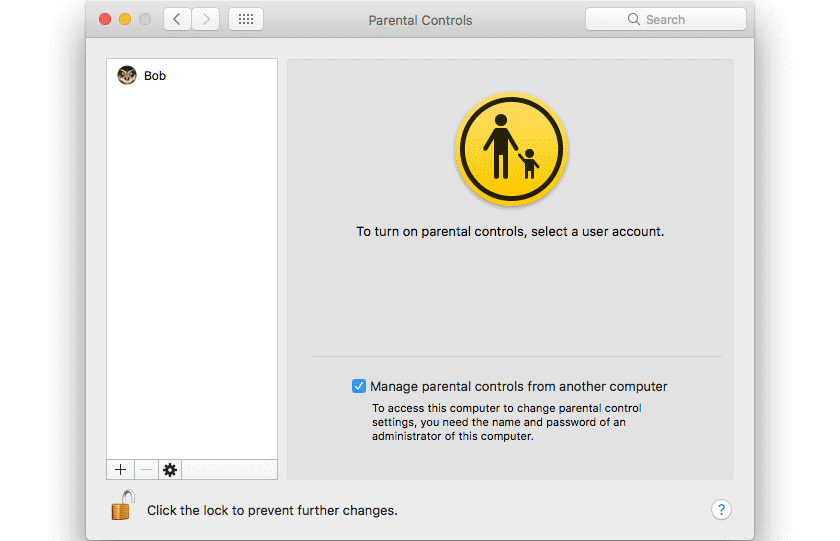
Apple’s macOS Parental Controls setup is very straightforward. Go to System Preferences > Parental Controls, select the account you want to manage and walk through the tabs as seen in the animation.
Intego ContentBarrier
Intego’s Parental Controls setup is equally simple, and it starts off by applying predefined protection levels for you in a setup assistant. Just drag the users to any of four fields to automatically apply the presets. This includes the administrator account if you want to have some content filtering as well.
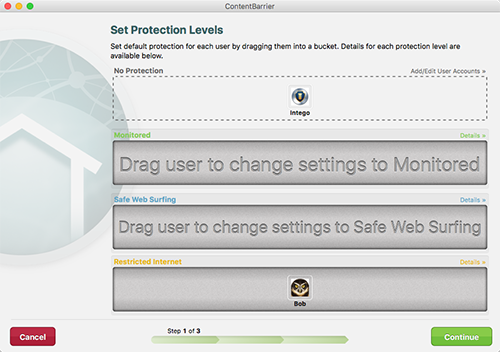
If you’re not sure which protection level is the best starting point, click the “Details” button provided by each field and ContentBarrier will tell you.
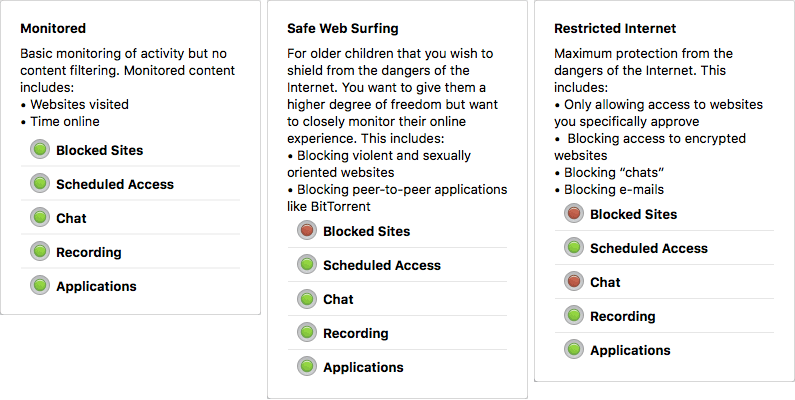
These settings can all be changed at any time.
The next step is configuring the notifications. Set up an email address that will send you a detailed report every day, week or month, and simply click a checkbox to make sure you receive creditor alerts immediately.
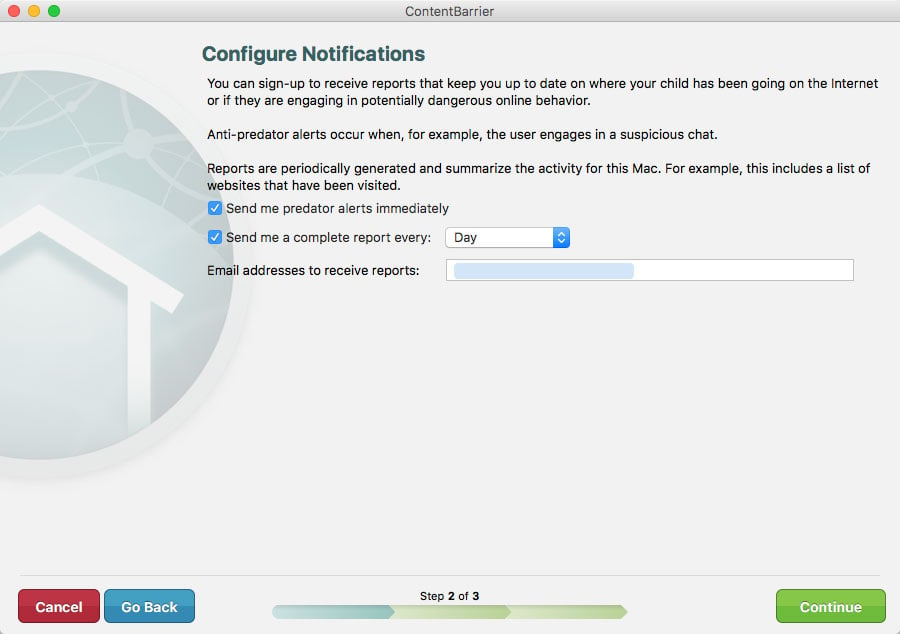
That concludes the setup assistant, and you will be taken into the configuration window. Walk through all the tabs and make the final adjustments.
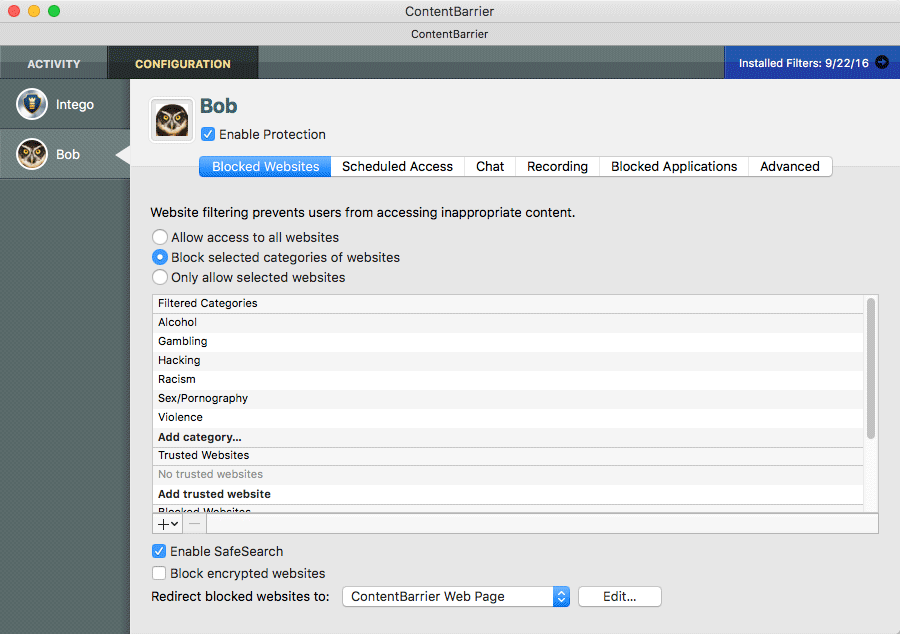
With the configuration done, let’s get down to the meat of the matter — product features!
Content Filtering
The content filtering feature is meant to monitor web browsing, email and chat for offensive, dangerous or otherwise preset contents.
macOS Parental Controls
Apple’s approach to content filtering is very straightforward. For web, you can select “unrestricted access,” or “try to limit access to adult websites,” or “only allow access to these websites” where you can enter your own list. Of course, when using macOS Parental Controls, you will most likely select the second option. You can enter some of your own sites to be always allowed (exceptions) or always blocked (blacklist regardless of contents). That’s it! Overall it does a pretty good job at keeping adult content out.
Intego ContentBarrier
Intego’s approach to content filtering is different and much broader than what Apple offers. Two of the three options are the same; unrestricted access and a whitelist of accessible websites, but the option that matters most is “Block selected categories of websites.”
Rather than just attempting to block adult content, a large amount of categories are available to choose from. If you want to block adult content, both Apple and Intego will get the job done; however, if you want to block gambling, profanity, web mail, social networks or anything else, only Intego ContentBarrier can do that for you.
In my testing, I found the categories to be very thorough and every site I pulled up to try and trick ContentBarrier failed to load. Additionally, you can set exclusions, blacklisted sites or custom keywords that, when found on a site, will block it. A SafeSearch option is available which, when enabled, will force Google in SafeSearch mode and cannot be disabled by the user on the Google website itself. The website that informs the user a website was blocked can be the default ContentBarrier page, another website or a custom local webpage.
But this was all about Web filtering, what about email and chat? Glad you asked!
Apple can limit the contacts a user is allowed to email. Unfortunately, that’s all I can say about it as that’s all there is. (No content filtering is done on emails.) As long as the email is to or from an approved contact, the contents don’t matter. ContentBarrier can allow all email, block all email or allow email with an AntiPredator filter on it to filter inappropriate content. If any of the words or phrases are found in an incoming or outgoing email, it will be blocked.
Content filtering does not apply to chats as far as Apple is concerned. Luckily, Intego ContentBarrier does offer some options. (You can allow all, block all, or allow with AntiPredator filtering.)
When it comes to filtering content, Intego’s ContentBarrier is clearly a better option.
Time Limits: Intego vs. Apple Parental Controls
There is a big difference in how Apple and Intego handle time limits. Apple’s time limits apply to the use of the computer only, whereas Intego’s time limits apply to the Internet usage. Using macOS Parental Controls, you set a daily time limit and a bedtime.
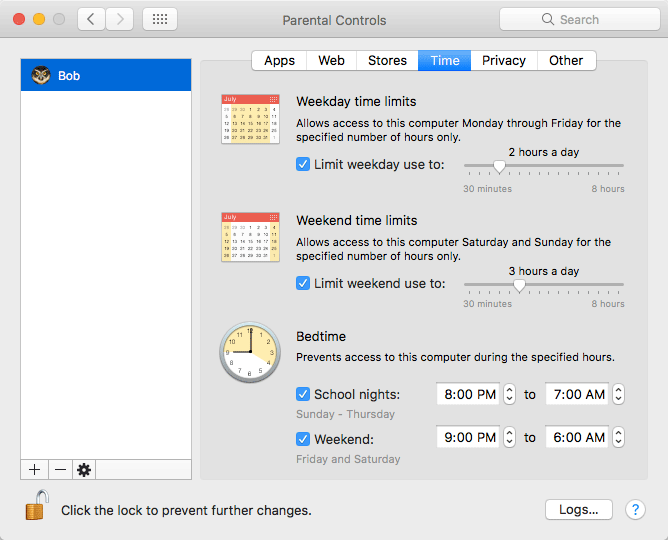
This implementation works well if you want to make sure your child uses the Mac only when they need to. They will figure out fast that the time spent on the computer should be used wisely (homework) and should not be squandered (social media, games etc.). There are several scenarios in which such strict rules will not work though, and in those cases an administrator can be prompted to add more time to the session.
Intego ContentBarrier only limits Internet usage, so while the Mac can be used at any time, Internet access during that time is limited. This implementation allows a child to use a text editor to type up an assignment without being distracted by social media or any of the thousand things that can cause a distraction while being connected to the Internet.
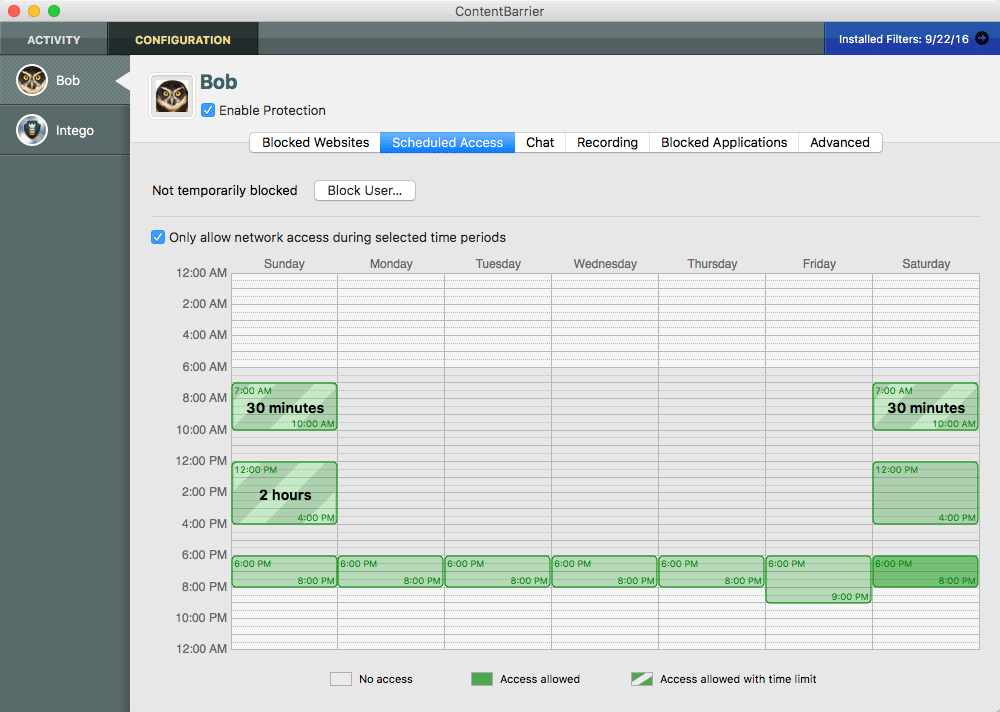
You can be flexible and say between 10 AM and 2 PM only 30 minutes of Internet is allowed or set a block of time where Internet is allowed for the whole duration.
Whichever implementation works best for you is only a call you can make, so I will not declare a winner here. For me, these two systems actually work really well together. I can use Apple’s Parental Controls to limit computer use while using Intego’s parental controls to limit Internet access. This allows me to set up very generous Apple time limits, but make sure a child is locked out when it’s bedtime, while setting very detailed ContentBarrier time limits during the time the Mac can be accessed. I call this one a tie!
Screen and Type Monitoring
Feelings on the monitoring of the screen and everything that’s typed are mixed for most people I spoke with. Parents want to protect their child but also give privacy where possible. So, what options do Apple and Intego offer? Is there a balance between making sure your child is not exposed to anything bad and protecting privacy?
macOS Parental Controls
Apple’s options: none. No screen or type monitoring is possible, period. There are no settings for it and it does not show in the logs.
Intego ContentBarrier
ContentBarrier offers the following choices: record nothing, screen only, type only or everything. Screenshots can be made at minute or hour intervals, all keystrokes can be recorded, and a list of applications that should not be monitored can be set. If your child is using TextEdit or Pages to keep a diary, for example, there is no need to know what’s being typed so those applications can be excluded. In this way, you’re keeping a balance between monitoring and privacy. Of course, snapshots and recorded keystrokes can be seen with remote management as well.
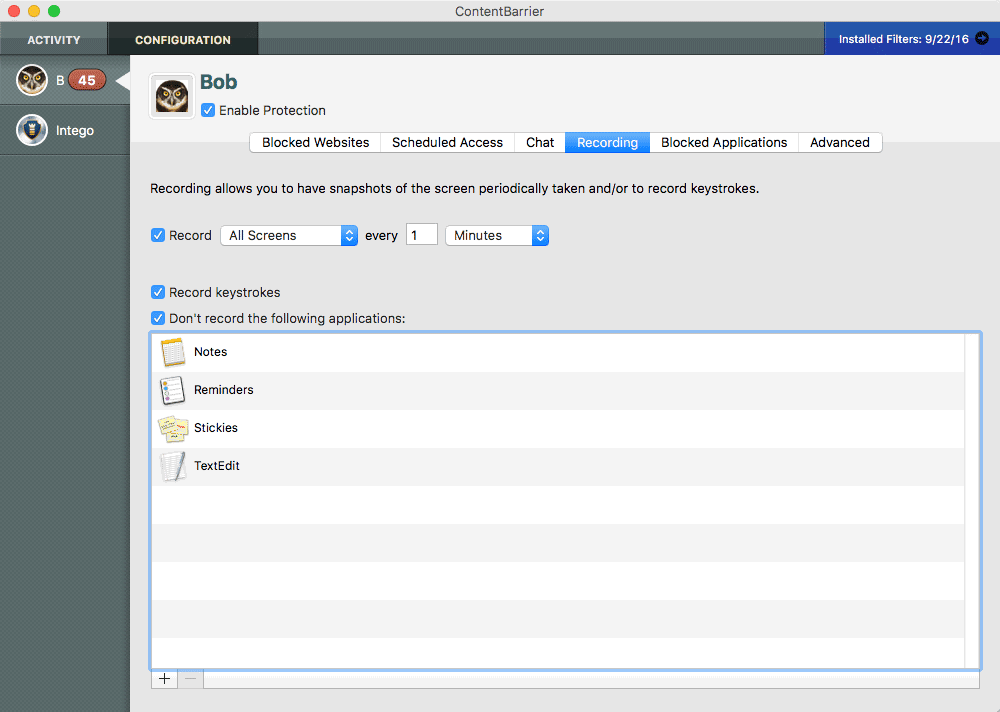
Again, the flexibility (and simply offering the feature and options) makes Intego ContentBarrier knock this one out of the park.
Application Blacklisting/Whitelisting
Blocking or allowing an application is a matter of checking a box in Apple’s macOS parental controls. If an application is blocked, it will simply not launch. ContentBarrier, as with time limits, focuses on network access instead. Any application can be opened, but you control if it’s able to access the Internet or not. These are clearly two different approaches where one may fit your needs better than the other. In my testing, both did exactly as advertised so I will call this one a tie.
Logging, Reporting and Notifications
You can’t keep an eye on your child’s computer usage habits around the clock, even with remote access (though it sure helps!), and you shouldn’t have to. At some point you have to trust that the parental controls are doing their job and don’t require your constant supervision or frequent check-ins.
That said, it is recommended to review daily activity; after all, kids have some really ingenious tricks to get what they want and trying to find a way around parental controls will likely be one of them. Reviewing logs, recorded content and alerts will show you if any settings need to be adjusted, so these logs need to be detailed and easy to digest.
macOS Parental Controls
Apple’s parental controls offer logs for application and web use. For applications, it shows which application were used, and how often and how long each were used. For web use, it shows which sites were visited, how often and on what date and time a site was accessed. The presentation sure is pretty, but essential information is missing.
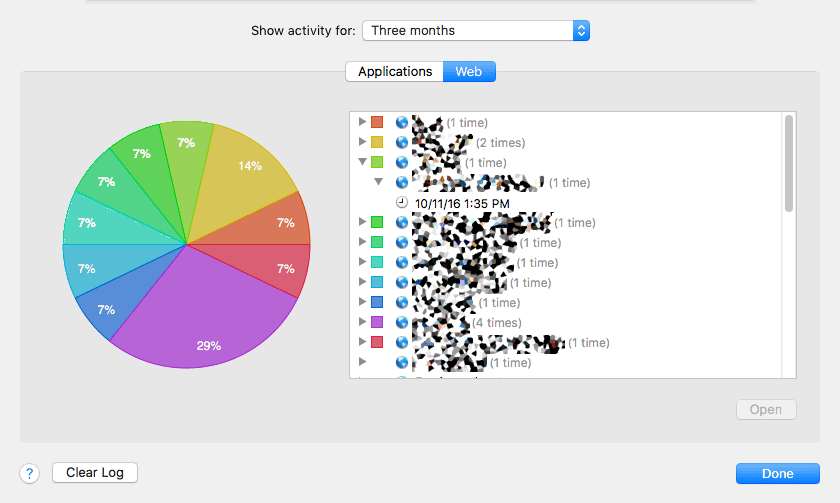
It only lists sites that were accessed successfully. Blocked sites are not shown, so you can’t spot attempts to access a certain type of content. There is also no way to click on a mentioned site to open it and check it out for yourself to review if it is suitable for your child. Hovering your mouse over a listed site will give you a pop-up URL, but this cannot be clicked to open or copied. After manually typing in a few of the exact URL’s as listed, you get tired of it very very fast.
Intego ContentBarrier
ContentBarrier parental controls show the activity sorted in several tabs. (i.e. Websites, Chats, Recording, Applications and Alerts.) The blocked applications, screen and keystroke recording could already be seen in action earlier with remote management. Here’s what the web content log looks like:
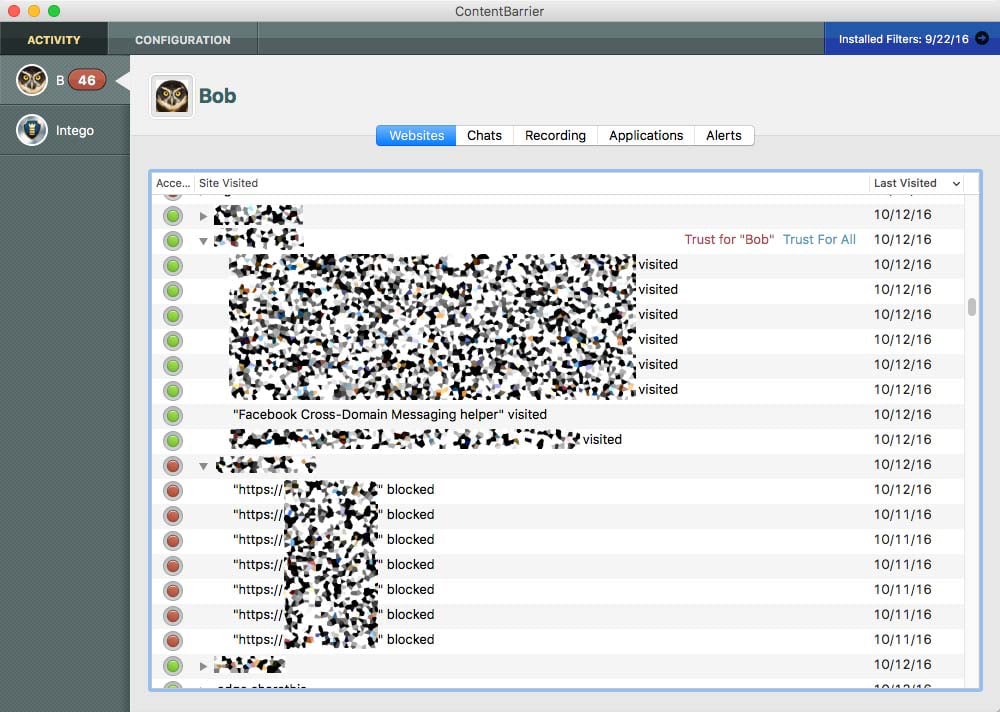
You can see detailed reporting on which sites were visited and blocked, including subpages that were clicked while on that website. Clicking one of the listed pages opens a pop-up window that loads the contents. There is also the daily report that can be sent to your email, if you chose to activate this in the setup assistant.
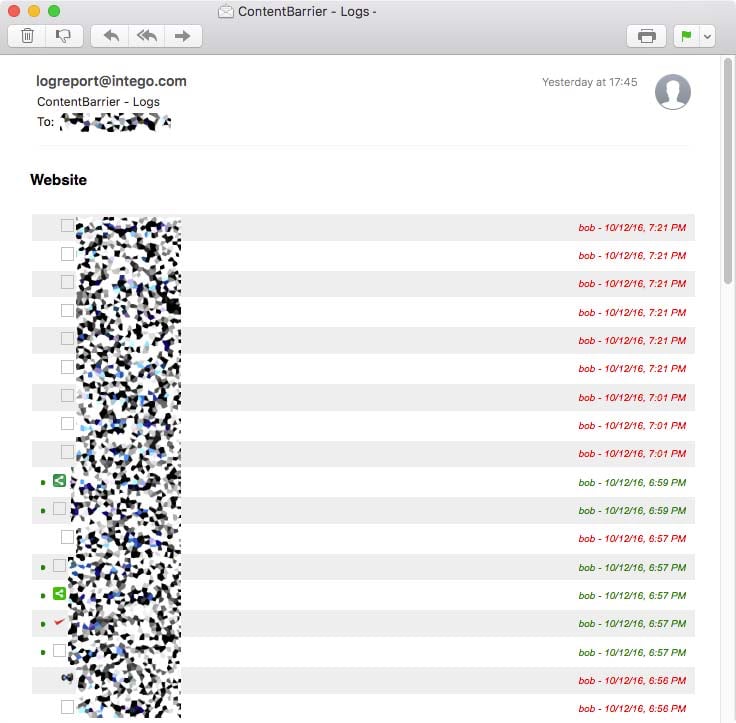
And, of course, predator alerts triggered by AntiPredator monitoring are sent to you immediately.
Intego’s ContentBarrier certainly offers features that are expected of in a modern parental control suite, whereas Apple’s parental controls have remained the same since its introduction in Mac OS X 10.4 Tiger in 2005. If you are still using Mac OS X, see: How Does Intego ContentBarrier Compare to Mac OS X’s Built-In Parental Controls?
A few features in macOS’s built-in Parental Controls can compliment Intego ContentBarrier, such as time limits and application blocking, but as can be seen in my full comparison above, ContentBarrier is by far the better parental controls solution for Mac.
Have something to say about this story? Share your comments below!